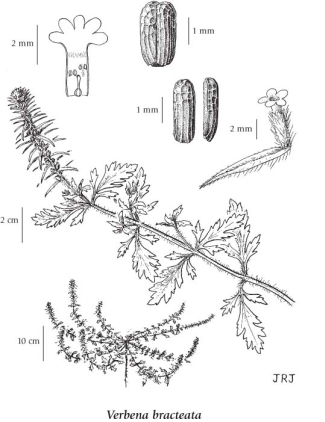Verbena bracteata Cav. ex Lag. & Rodr.
bracted vervain (bigbract verbena)
Verbenaceae (Verbena family)
Introduction to Vascular Plants
bracted vervain (bigbract verbena)
Verbenaceae (Verbena family)
Introduction to Vascular Plants
Species Information
General:
Annual or more often perennial herb from a taproot; stems prostrate or decumbent, few to numerous, simple, spreading-hairy, 10-60 cm long.
Leaves:
Basal leaves lacking; stem leaves opposite, oblanceolate, 2-5 cm long, 1-2.5 cm wide, coarsely bristly, wing-stalked, irregularly toothed and cleft with pinnate segments, the terminal segments larger.
Flowers:
Inflorescence of terminal racemes up to 15 cm long with lance-linear bracts and inconspicuous flowers; corollas bluish or pinkish, sometimes white, 4-5 mm long, almost hidden by prominent bracts exceeding the calyces, lobed, the lobes about 1/4 the length of the tubes; calyces cylindric, 2.5-4 mm long, bristly-hairy.
Fruits:
Nutlets, 1-2 mm long, with prominent ribs, cross-corrugated above.
Illustration

If more than one illustration is available for a species (e.g., separate illustrations were provided for two subspecies) then links to the separate images will be provided below. Note that individual subspecies or varietal illustrations are not always available.
Illustration Source: The Illustrated Flora of British Columbia
Ecology
Ecological Framework for Verbena bracteata
The table below shows the species-specific information calculated from
original data (BEC database) provided by the BC Ministry of Forests and Range.
(Updated August, 2013)
The table below shows the species-specific information calculated from
original data (BEC database) provided by the BC Ministry of Forests and Range.
(Updated August, 2013)
| Site Information |
Value / Class |
||
|
Avg |
Min |
Max |
|
| Elevation
(metres) |
385 | 335 | 457 |
| Slope
Gradient (%) |
15 | 9 | 27 |
|
Aspect (degrees) |
217 | 202 | 225 |
| Soil
Moisture Regime (SMR) [0 - very xeric; 4 - mesic; 8 - hydric] |
5 | 5 | 5 |
| Modal
Nutrient Regime
Class |
|||
| #
of field plots species was recorded in: |
3 | ||
| Modal
BEC Zone Class |
BG | ||
|
All BEC Zones (# of stations/zone) species was recorded in |
BG(3) | ||
|
Source:
Klinkenberg 2013
|
|||
Habitat and Range
Mesic to dry sandy sites, roadsides and disturbed areas in the steppe and montane zones; rare in SW BC, locally frequent in SC BC; E to ON and S to ME, NH, NY, PA, NC, FL, MS, LA, TX, NM, AZ, CA, and MXStatus Information
Synonyms
Synonyms and Alternate Names:
Verbena bracteosa Michx.
Verbena imbricata Woot. & Standl.
Taxonomic Keys
1. Plants usually prostrate or decumbent; leaves, or at least many of them, deeply cleft; bracts of the inflorescences conspicuous, exceeding the calyces.....................Verbena bracteata
1. Plants erect; leaves merely toothed or shallowly lobed; bracts of the inflorescences inconspicuous, slightly surpassed by the calyces.........................Verbena hastata |